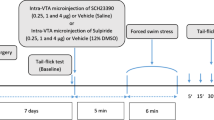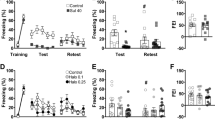Abstract
The effects of drugs which alter dopaminergic function on footshock-induced antinociception were studied in the rat. Antinociception due to brief (30 s) footshock was inversely related to dopamine (DA). Thus, it was increased by the DA receptor antagonists pimozide and haloperidol and decreased by the specific D2 dopamine receptor agonist LY 141865, but not by the specific D1 agonist SKF 38393. Although pimozide increased the antinociceptive effect of 30-s shock, it decreased that of 30-min shock. It is suggested that DA may have physiological roles in stress-induced antinociception, and that these may differ according to the duration of stress.
Similar content being viewed by others
References
Buckett WR (1981) Pharmacological studies on stimulation produced analgesia in mice. Eur J Pharmacol 69:281–290
Curzon G, Hutson PH, Tricklebank MD (1981) Involvement of dopamine in the analgesic response induced by footshock. Br J Pharmacol 74:761P
Doi T, Sawa N (1980) Antagonistic effects of psycholeptic drugs on stress-induced analgesia. Arch Int Pharmacodyn 247:264–274
Dunai-Kovacs Z, Szekely JI (1977) Effect of apomorphine on the antinociceptive activity of morphine. Psychopharmacology 53:65–72
Gonzalez JP, Sewell RDE, Spencer PSJ (1980) Dopaminergic involvement in the hyperalgesic effect of nomifensine. Life Sci 28:951–956
Grau JW, Hyson RL, Maier SF, Madden J, Barchas JD (1981) Long-term stress-induced analgesia and activation of the opiate system. Science 213:1409–1411
Hutson PH, Tricklebank MD, Curzon G (1983) Analgesia induced by brief footshock: blockade by fenfluramine and 5-methoxy-N,N-dimethyltryptamine and prevention of blockade by 5 HT antagonists. Brain Res 279:105–110
Kulkarni SK (1980) Heat and other physiological stress-induced analgesia: catecholamine mediated and naloxone reversible response. Life Sci 27:185–188
Lewis JW, Cannon JT, Liebeskind JC (1980) Opioid and non opioid mechanisms of stress analgesia. Science 208:623–625
Nakamura KR, Kuntzmann A, Maggio J, Conney AM (1973) Decrease in morphines analgesic action and increase in cataleptic action by 6-hydroxydopamine injected bilaterally into, caudate and putamen areas. Neuropharmacology 12:1153–1158
Robertson J, Weston R, Lewis MJ, Barasi S (1981) Evidence for the potentiation of the antinociceptive action of morphine by bromocriptine. Neuropharmacology 20:1029–1032
Setler PE, Sarau HM, Zerkle CL, Saunders HL (1978) The central effects of a novel dopamine agonist. Eur J Pharmacol 50:419–431
Snow AE, Tucker SM, Dewey WL (1982) The role of neurotransmitters in stress induced antinociception (SIA). Pharmacol Biochem Behav 16:47–50
Tricklebank MD, Hutson PH, Curzon G (1982) Analgesia induced by brief footshock is inhibited by 5-hydroxytryptamine but unaffected by antagonists of 5-hydroxytryptamine or by naloxone. Neuropharmacology 21:51–56
Tricklebank MD, Hutson Ph, Curzon G (1983) Analgesia induced by brief or more prolonged stress differs in its dependency on naloxone, 5-hydroxytryptamine, and previous analgesia testing. Neuropharmacology (in press)
Tsuruta K, Frey EA, Grewe CW, Cote TE, Eskay RL, Kebabian JW (1981) Evidence that LY 141865 specifically stimulates the D2 dopamine receptor. Nature 292:463–465
Author information
Authors and Affiliations
Rights and permissions
About this article
Cite this article
Tricklebank, M.D., Hutson, P.H. & Curzon, G. Involvement of dopamine in the antinociceptive response to footshock. Psychopharmacology 82, 185–188 (1984). https://doi.org/10.1007/BF00427770
Received:
Accepted:
Issue Date:
DOI: https://doi.org/10.1007/BF00427770




